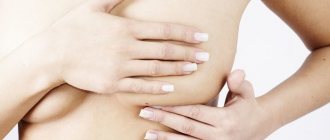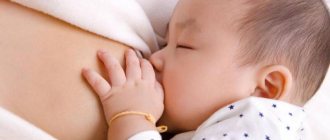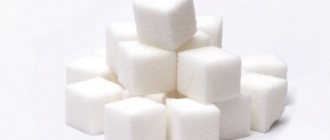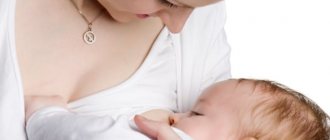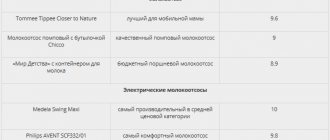Breast milk is the best nutrition for newborns and babies up to 12 months of age. Therefore, every mother tries to maintain natural feeding for as long as possible: despite all the “force majeure” and the need to leave the child from time to time, leaving him in the care of a nanny or grandmother.
In such situations, products from manufacturers of breastfeeding accessories come to the rescue. Today’s review is devoted to the issue of choosing some of them, namely containers for storing expressed milk.
How to store expressed breast milk
Storage containers vary - from ordinary bottles to specialized branded devices. Bottles are suitable if you need to store some milk and for a short period of time, as they take up a lot of space. You can use both plastic and glass, but you need to be careful with the latter, as when freezing the milk expands and the glass may crack.
Also, do not use regular plastic bags. Firstly, they are not sterile, so their shelf life is much shorter. Secondly, such bags are not airtight and the milk gets saturated with the odors of the refrigerator, and also leaks.
It is more convenient to store breast milk in containers specially designed for this purpose. They ensure the sterility of the product and protect it from refrigerator odors. They are convenient not only for storage, but also for collecting breast milk. Some companies even produce kits consisting of a breast pump and a storage container.
To preserve the beneficial properties of the product longer, you need to express it correctly. All utensils must be sterile, and it is also advisable to make sure your hands and chest are clean. To make milk flow easier, you can put a warm diaper on your chest and drink some warm water or tea before starting the procedure. Then get comfortable and express breast milk with your hands or a breast pump into prepared containers.
Accessories from NUK
High-quality, inexpensive products of the German brand NUK have already found their admirers in more than 100 countries around the world.
NUK containers are chosen by mothers who want to preserve every drop of precious “biological” nutrition for their baby. These containers are convenient for expressing breast milk; they can be used to freeze, defrost, and store dairy products until feeding.
Compact bottle containers can be reused multiple times and are sterilizable. For convenience, a small marking space is allocated on each container: so that you can indicate the date of pumping and orient yourself when “making a menu” if we are talking about long-term storage and freezing.
NUK containers are compatible with brand breast pumps and pacifiers (e-Motion, FIRST, CHOICET).
Containers
Containers are excellent containers for storing breast milk. They are sterile, suitable for reusable use and long-term freezing. They are convenient to store and easy to use - most containers can be attached directly to the breast pump and immediately express there. They are completely safe and do not affect the taste and composition of milk.
Containers can be of two types - glass or plastic. Glass, at a fairly high price, is considered a higher quality and safer material. It does not contain toxic elements or compounds, it is easy to care for, and in addition, glass does not turn yellow with prolonged use, as happens with plastic.
However, glass containers also have a number of disadvantages:
- they must be sterilized before each use;
- not suitable for long-term storage;
- Milk fats easily settle on the walls of such containers, which slightly reduces the overall nutritional value of the milk.
And, of course, glass containers are easy to break, so they require much more care than plastic ones.
Plastic containers are much cheaper, which makes them attractive to many mothers. When choosing such containers, you should pay special attention to the quality of the plastic. Cheap products may be cast from inexpensive polycarbonate, which under certain conditions can release harmful compounds. These containers are usually solid and clear and are marked "O" or "Other".
Preference should be given to food-grade plastics marked PP, numbers 5, 2, 4 in a triangle sign. Also a good sign would be the inscription “Does not contain bisphenol A”/Bisphenol free/BPA Free and the like. Baby-safe plastics are usually cloudy and soft. It is recommended to heat plastic containers no more than 20 times, and preferably 4-5 times. If there is the slightest sign of surface damage - cracks, scratches - the container should be thrown away.
Canpol Babies
Milk storage containers from the Polish brand Canpol Babies are made of polypropylene, a safe food grade plastic. The package contains from 1 to 4 containers with a capacity of 180 ml. There is a scale on the wall that helps you determine the serving size and the amount of food to be stored. Each container comes with a lid to ensure the container is sealed. They can be used later - for storing purees and other baby dishes. Containers for storing breast milk can be used in conjunction with breast pumps from this company, Easy Start brand.
Avent containers
Containers for collecting and storing milk from Avent are equipped with airtight lids, as well as adapters for feeding and connecting to a breast pump. The volume of the containers is 180 ml, they are made of safe plastic that does not contain bisphenol A. They can be used to store other types of baby food, in addition, you can feed the baby from these containers.
Medela containers
Breast milk containers from Medela are quite inexpensive. The set includes three containers with tight lids and protective discs. The volume of these containers is slightly smaller than the previous ones - only 150 ml. There is also a scale on the walls to help you determine the portion and volume.
Combined with Medela breast pumps, the containers are suitable for direct expression as well as for storing various types of baby food. You can attach a pacifier from the same brand to them and feed the baby, which is very convenient. Milk in these containers can be stored in the refrigerator, freezer, frozen, and can be conveniently used for transportation.
What should you pay attention to when choosing containers for baby food?
It would be wiser to give preference to compact, small containers with a volume of 60-90 ml: infants drink milk more often, but in smaller portions, unlike bottle-fed children. In addition, liquid in small containers defrosts faster.
A breast milk container is an item that you should not skimp on, since the quality of the material from which it is made depends on the health of your baby. The questionably low price should alert you. Therefore, pediatricians recommend giving preference to well-known manufacturers, the quality of their products is confirmed by numerous studies and certificates.
So, what do the biggest brands of children's accessories offer us?
Packages
Bags for collecting and storing breast milk are also quite a convenient device that has many advantages:
- sterility. The bags are sealed and do not allow the milk to become saturated with foreign odors, and also protect against the ingress of bacteria;
- convenient to store. They do not leak or burst when frozen, and in addition, they can be laid on their sides, so they take up less space in the freezer;
- convenient to use. Excess air can be easily removed from the bags to extend shelf life. In most cases, there are special notches on the side indicating the volume. Plus, it’s easy to write the date and time of pumping on them with a marker or pen.
In addition, most bags can be attached to a breast pump, which makes collecting milk much easier. Manufacturers offer a large selection of packages that vary in volume, price, and design.
Avent
Philips Avent breast milk bags are made of safe plastic that does not contain bisphenol A. The package contains 25 bags, each containing 180 ml.
All new bags have a seal indicating their sterility and hygienic safety. Avent breast milk freezing bags are very reliable, as they have double walls, sealed seams and a stable shape. All together allows you to conveniently express milk in them and store it securely. The sealed closure provides protection against refrigerator odors, leaks and bacteria. And special notches on the wall allow you to monitor the amount of expressed milk.
Medela
Medela breast milk freezer bags work well with breast pumps of the same brand. They can be easily attached to the device using a special tape that is included in the kit. The package contains 20 bags of 150 ml. The containers are sterile, and the zipper protects against the entry of bacteria from the outside, as well as from leaks or foreign odors. Double walls also provide additional protection for expressed milk. You can store even small portions in bags; it is not necessary to fill them to the brim.
Dr. Brown's
Disposable bags “Dr. Brown's" is made from medical grade polyethylene. It does not affect the taste or smell of milk, and allows you to maintain complete sterility. The package contains 25 bags with a capacity of 180 ml. Each storage bag has a special scale and strip for signing the date and time of pumping. To protect against leakage, a zipper is used.
Bottles
You can also use branded bottles to store breast milk.
They are convenient to use for both pumping and storage. Breast milk from a bottle is convenient to freeze and thaw, and you can also feed your baby directly from it without using unnecessary items. They can also be made of glass and plastic. On the walls, as a rule, there is a scale with divisions indicating the volume of milk. The volume of bottles can be different, for example, Medela produces them in two sizes - 150 and 250 ml. Some types of bottles can be connected to breast pumps from the appropriate brand.
Containers for expressed milk CHICCO
Once upon a time, the birth of a long-awaited son in the family of Italian entrepreneur Pietro Catelli became the root cause of the emergence of the CHICCO company. The brand, specializing in the production of products “for the little ones” (0-36 months), is unconditionally trusted by parents all over the world. That’s why they buy up massive amounts of not cheap accessories for breastfeeding in online stores.
CHICCO offers its customers traditional European quality and safety:
- containers for expressed milk made of environmentally friendly, impact-resistant plastic, free of harmful Bisphenol A;
- compact containers that can be used for defrosting and heating baby food in the microwave;
- Chicco containers can be washed in the dishwasher, which, although slightly, makes life easier for a young mother;
- defrosted and heated milk can be given to the baby directly from the container, without wasting the food collected with difficulty on bottling;
- airtight lids, silicone nipple and clip included.
How to freeze and defrost
Freezing breast milk should follow proven rules. This is necessary in order to fully preserve the benefits of the product for the baby. The rules do not depend on whether the mother uses a milk container or freezes it in bags or other containers.
All pumping equipment must be washed and sterilized. On containers with expressed milk, be sure to write the date of freezing to make it easier to track the expiration date.
Breast milk from the refrigerator should be warmed gradually. You cannot place the container in hot water or a microwave; it needs to be thawed in the refrigerator, so you need to start defrosting in advance. Read a detailed article on how to freeze and store breast milk.
Mother's milk is the ideal nutrition for any baby, and it is not at all necessary to refuse breastfeeding if weaning is necessary. Using special containers and bags, you can preserve their beneficial properties for a long time.

